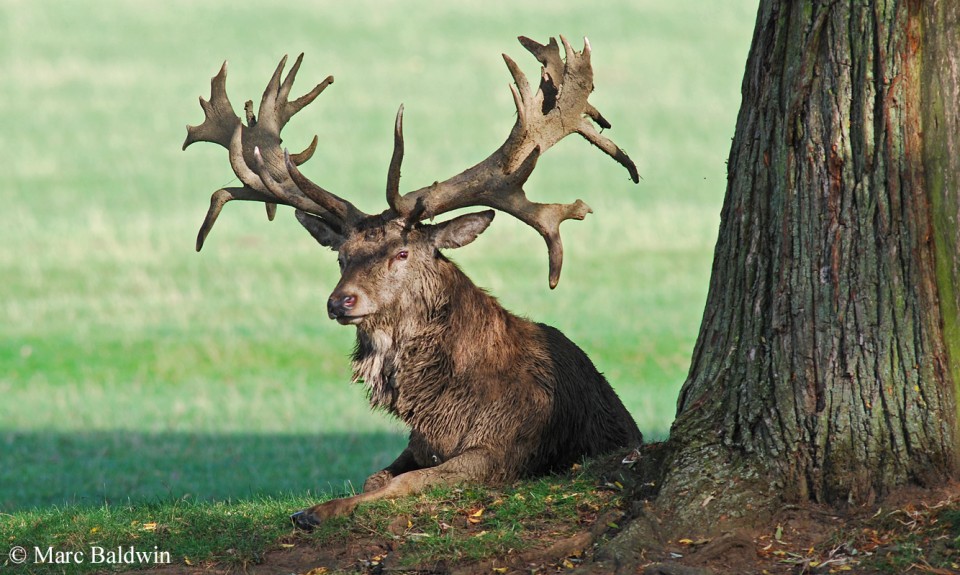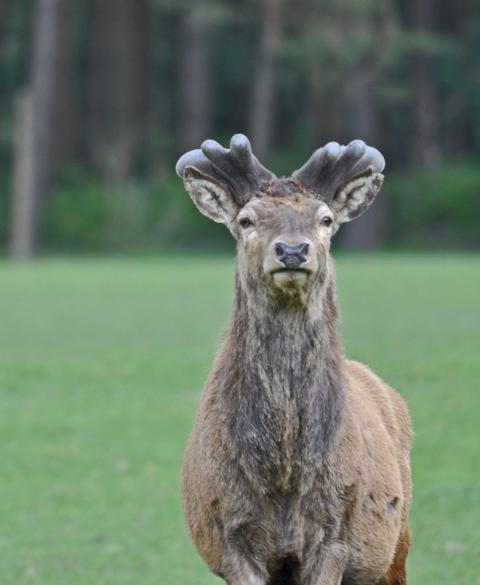Red Deer Antlers
The growth and formation of antlers is a complex process that appears to be a process known as modified endochondral ossification - in other words, a cartilage skeleton is turned to bone. Red deer antlers may reach 90 cm (3 ft.) in length and weigh 3 kg (6.6 lbs) each, although 70 cm (2 ft. 4 in.) and 1 kg (2.2 lbs) is more common. During their development, the antlers are soft and vulnerable to damage and covered in a greyish-purple coloured membrane called velvet. The velvet carries nerves and blood vessels to the developing antlers and, should the velvet become damaged, the antlers can become deformed.
Antlers have androgen (male sex hormone) receptors and it appears that an increase in testosterone levels in the stag -- probably related to decreasing day length -- causes a cessation of the velvet's blood supply, causing the bone to die and dry out - at this stage, dry velvet can be seen hanging from the stag's antlers and he is said to be "in tatters". Dry velvet is usually removed by rubbing the antlers against trees and bushes during summer (typically during July), a process known as "cleaning", and during this rubbing the antlers become stained with tannins and sap from the trees and saplings, turning them from white to a polished chestnut brown.

The rate of antler growth varies according to conditions, but may be as high as six centimetres (2.5 inches) per day in prime stags living in good conditions. A good quality mature individual will have 12 to 15 branches (called tines or points) to his antlers and stags are often named according to the number of these points. Antler development typically begins at around 10 months of age and by his second year a stag will, provided the conditions are good, have his first "head" - these are short, simple, unbranched antlers and at this point he is referred to as a brocket.
Over subsequent years the antlers should become progressively larger and branched. It should be noted, however, that the number of tines is an unreliable indication of age and, once the stag passes about 10 years old, the number of tines often starts to decline in a stage known as "going back". A Red deer with 12 points (six per antler) to his antler is called a Royal stag, while 14 points make an Imperial stag and an animal with 16 points or more is referred to as a Monarch.

In his article for South Coast Today, a Massachusetts news and current affairs website, outdoor writer Marc Folco described how hunters often speak in terms of "pointers". Folco explains that a deer with five tines each side is a five-pointer, while one with six either side is a six-pointer. In cases where the antlers are asymmetrical (i.e. different number of tines each side), the two values are given separated by an X - thus, a deer with six tines on one antler and five on the other is a "6 X 5", rather than an 11-pointer.
The names given to the year classes of male Red deer, often assigned based on the level of antler development, are:
Yearling = Calf
Second Year = Brocket
Third Year = Spayad
Fourth Year = Staggard
Fifth Year = Stag
Sixth Year = Hart
Seventh + Year = Great Hart
The antlers -- which are fully developed and cleaned by August -- are used during rutting; they are employed as weapons with which to fight for access to hinds. Come March or April, increasing day length triggers a reduction in the amount of circulating testosterone, which causes the antlers to be shed and the cycle to begin again. The time of casting seems to be fairly stable, at least for some stags - in his excellent book WildGuide, Simon King mentions one old stag he knew that cast his antlers on or about 15th March each year for eight years.
Shed antlers and velvet represent a veritable goldmine of nutrients for many animals, including both sexes of deer. Antlers contain a variety of essential elements, including calcium, phosphorous, sulphur, magnesium, potassium, sodium and iron, as well as various amino acids, including all eight essential ones (i.e. those that are required in the diet and can't be synthesized by the animal). Consequently, it is not uncommon to find deer chewing on an antler or velvet they (or another deer) have recently shed.
More comprehensive coverage of the structure and formation of antlers, as well as a discussion of the various theories proposed to explain their evolution can be found in the antler QA.